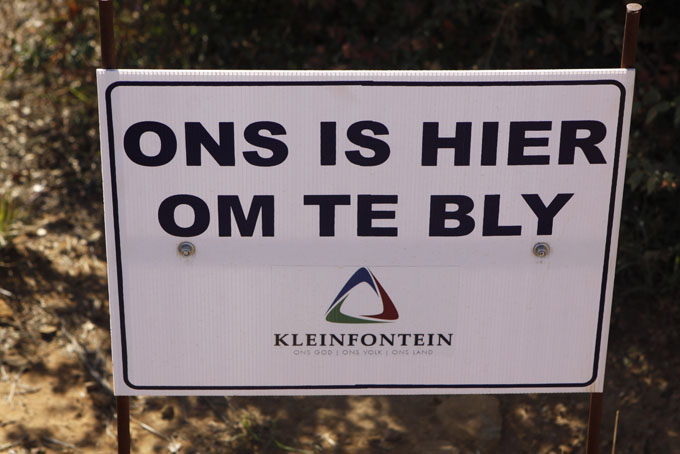
In this photo taken Wednesday, May 29, 2013 a sign outside a home reads “We Are Here To Stay” and at bottom, “Our God, Our Nation, Our Land” in Kleinforntein, near Pretoria, South Africa. id era that ended with democratic elections in 1994. (AP Photo/Denis Farrell)
by Christopher Torchia
KLEINFONTEIN, South Africa (AP) — There are no signs that say “Whites Only.”
There are, though, men in military fatigues who log the license plates of vehicles approved to enter Kleinfontein, a rural enclave that is home to about 1,000 Afrikaner Whites. And there is a bust of Hendrik Verwoerd, the former South African leader who spearheaded White racist rule.
This exercise in separate, self-sufficient living near the South African capital, Pretoria, is more than just a throwback to the apartheid era that ended with the country’s first all-race elections in 1994. In recent days, Kleinfontein and its campaign to be formally recognized as a township have become a touchstone for fresh debate about law, freedom and the kind of “rainbow nation” that South Africa is trying to be.
Kleinfontein, which is all private property, requires its residents to be Afrikaners, descendants of settlers who arrived from Europe centuries ago and speak Dutch-based Afrikaans, the idiom of South Africa’s former overseers. That brings accusations of racism in a nation whose population of over 50 million is mostly Black, but the community skirts race references in its manifesto. Descendants of British settlers, for example, would not be welcome to live here.
The community is not organized “on the basis of race,” said Jan Groenewald, chairman of the board of directors of Kleinfontein, which means “Little Fountain” in Afrikaans. Instead, he said, the goal is to preserve a cultural bedrock that stretches back to the lore of the hardy Voortrekker settlers.
The dig-in mindset at the austere settlement echoes that of its ancestors, who drew ox wagons into a defensive circle, a tactic that helped them defeat a much bigger Zulu force at the Dec. 16, 1838 Battle of Blood River. The date has near-mystical import for staunch Afrikaners, though the vast majority of Whites accepted South Africa’s new, multi-racial order in 1994 as part of a negotiated settlement.
“We are here to stay,” read Afrikaans-language signs outside modest brick-and-tile homes linked by dirt roads in Kleinfontein.